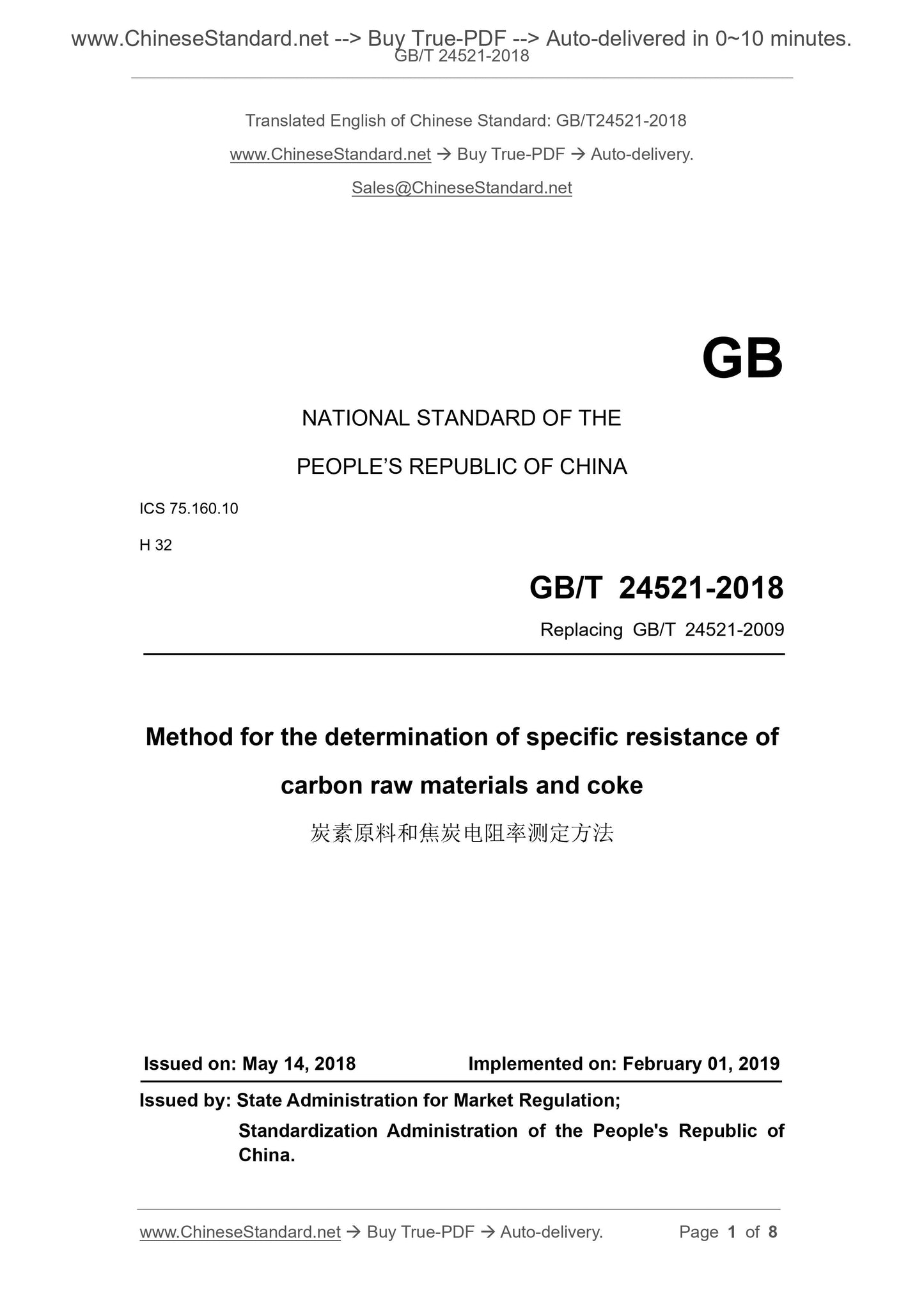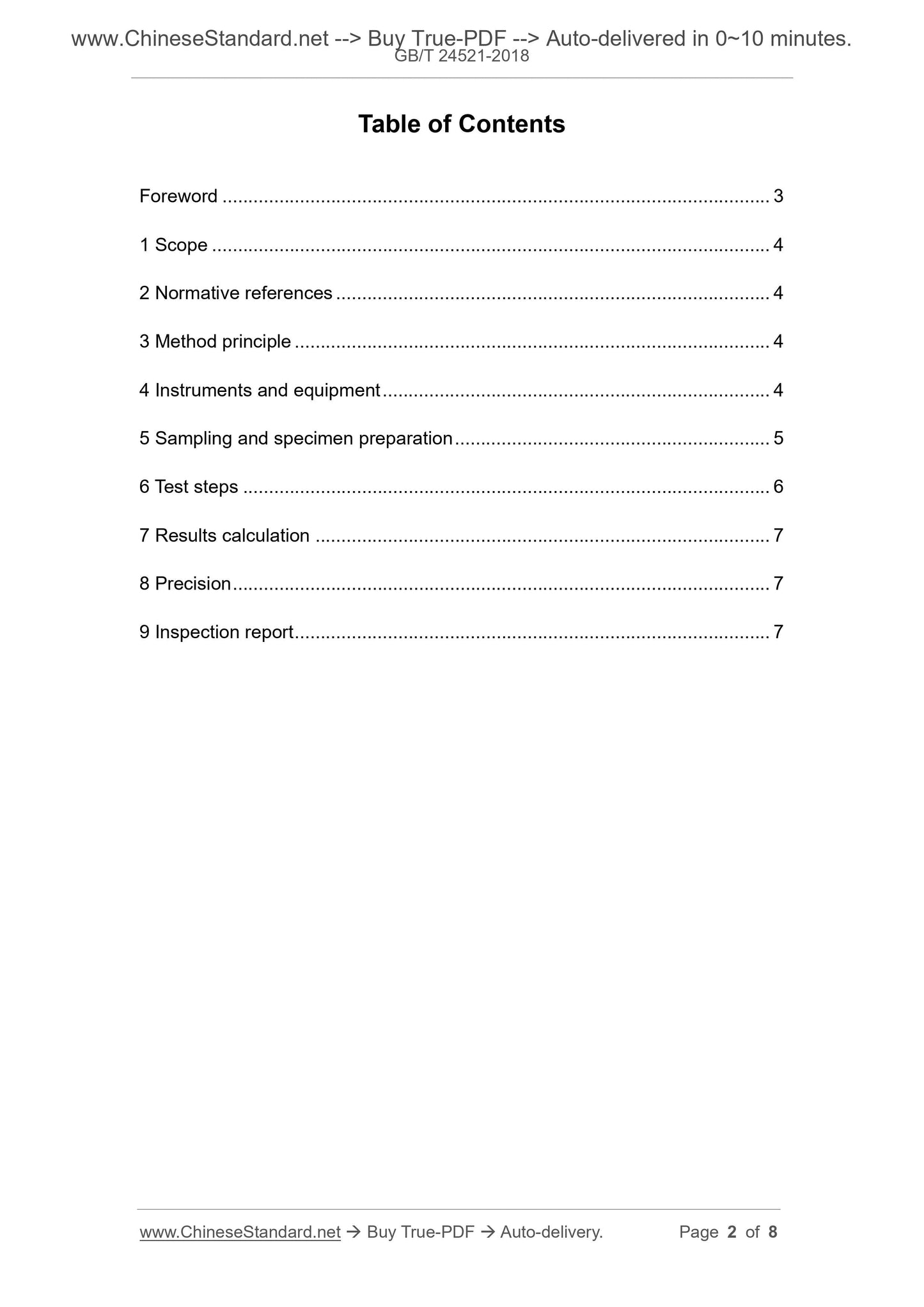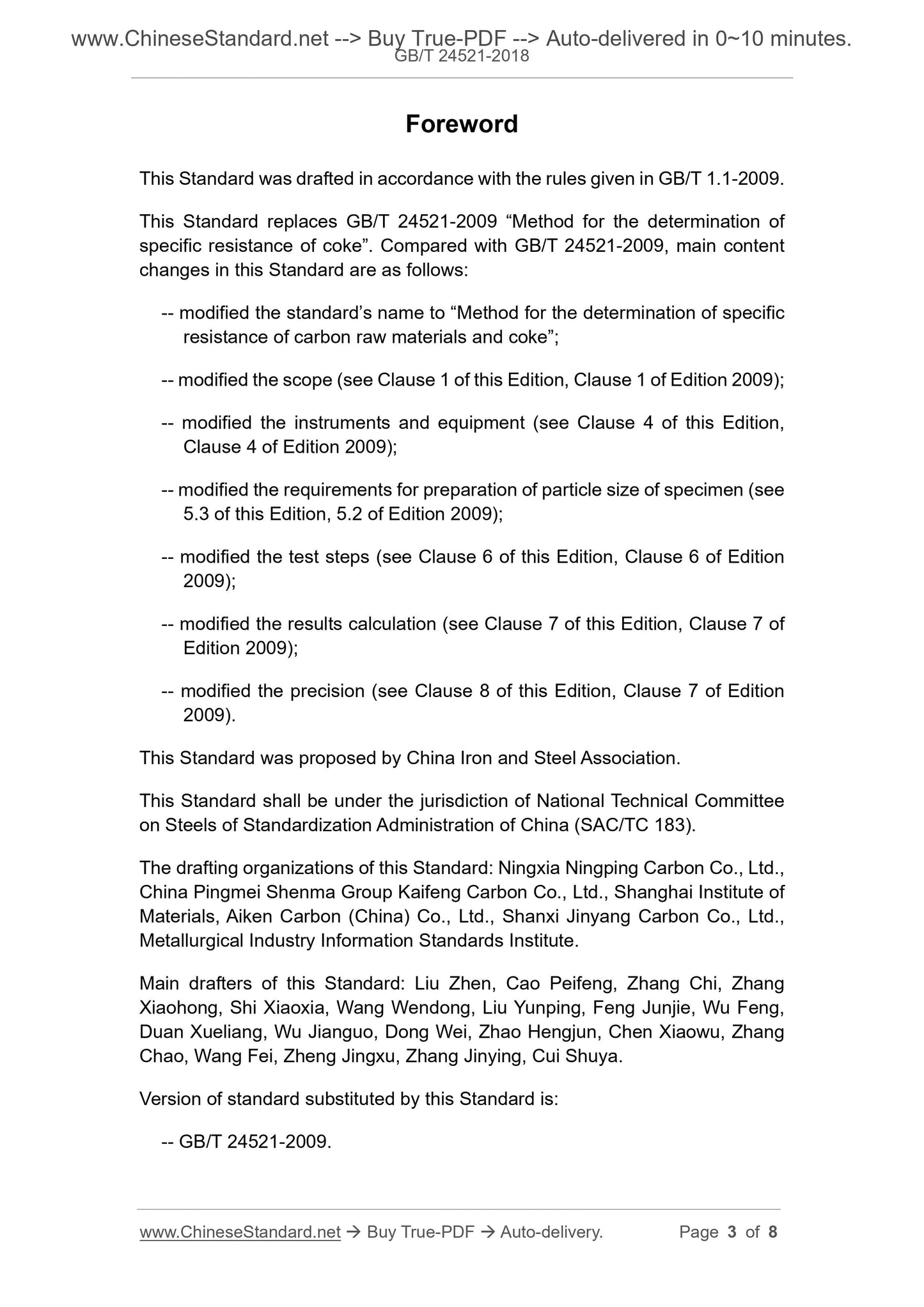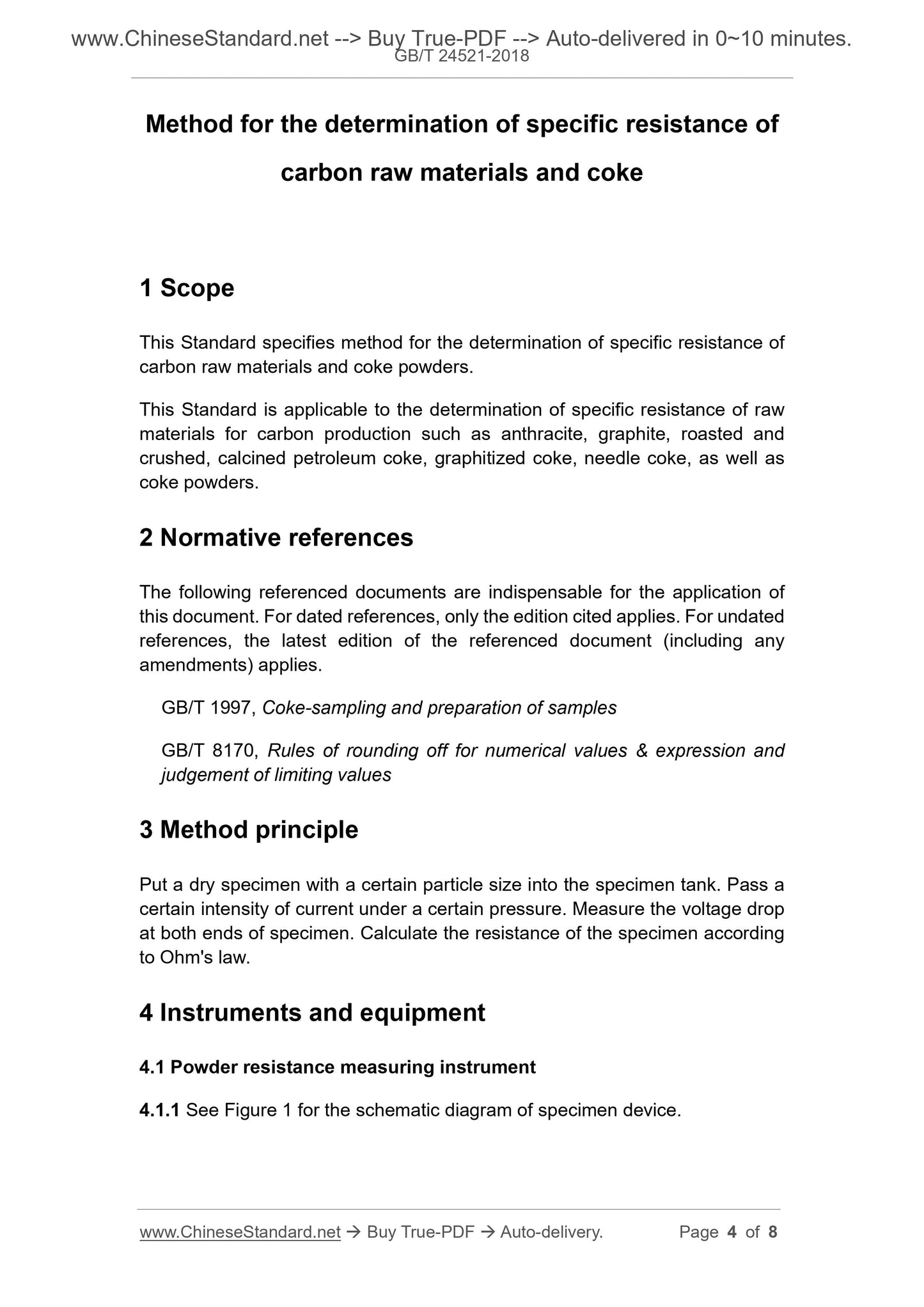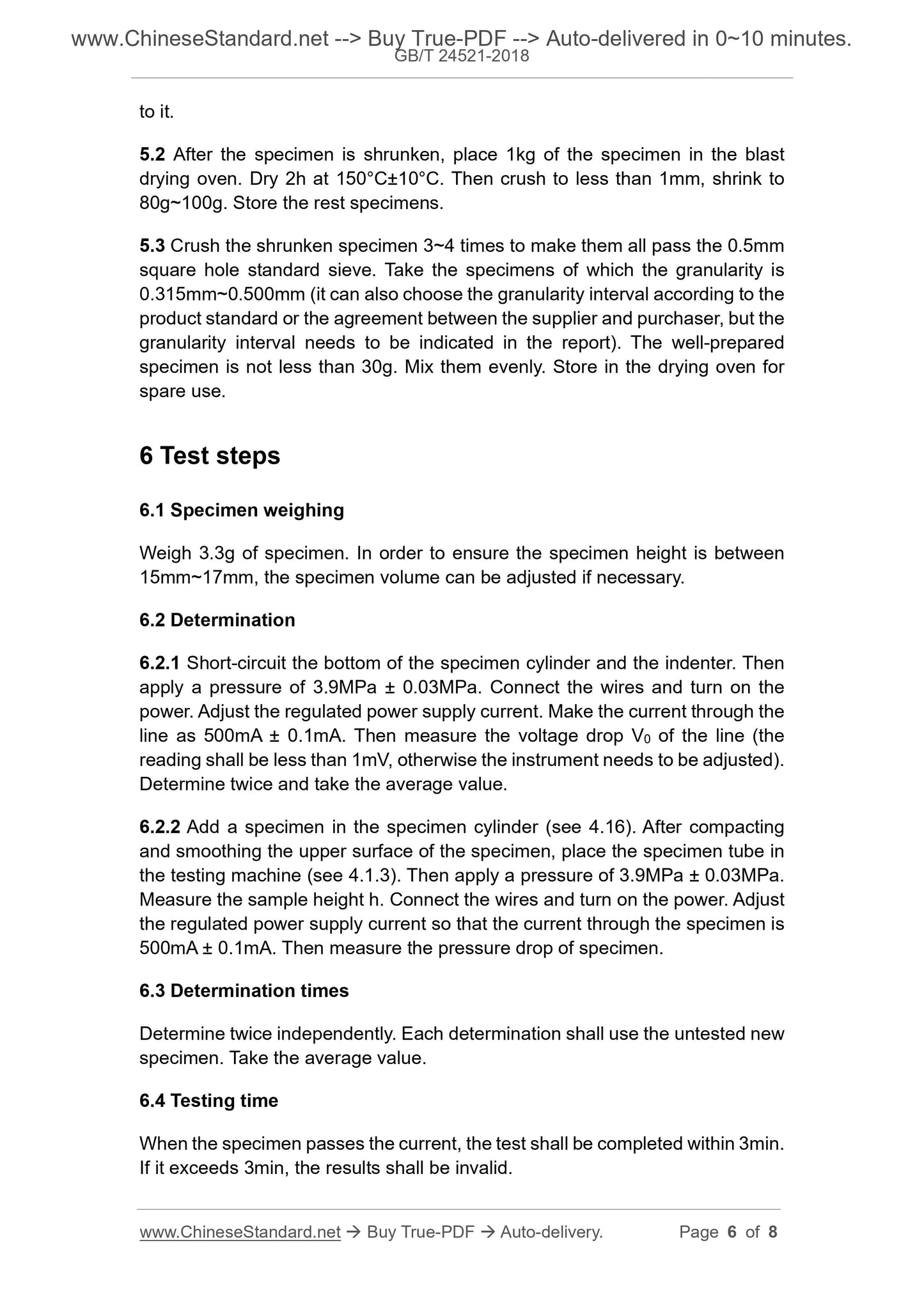1
/
of
5
PayPal, credit cards. Download editable-PDF and invoice in 1 second!
GB/T 24521-2018 English PDF (GBT24521-2018)
GB/T 24521-2018 English PDF (GBT24521-2018)
Regular price
$85.00 USD
Regular price
Sale price
$85.00 USD
Unit price
/
per
Shipping calculated at checkout.
Couldn't load pickup availability
Delivery: 3 seconds. Download true-PDF + Invoice.
Get QUOTATION in 1-minute: Click GB/T 24521-2018
Historical versions: GB/T 24521-2018
Preview True-PDF (Reload/Scroll if blank)
GB/T 24521-2018: Method for the determination of specific resistance of carbon raw materials and coke
GB/T 24521-2018
NATIONAL STANDARD OF THE
PEOPLE’S REPUBLIC OF CHINA
ICS 75.160.10
H 32
Replacing GB/T 24521-2009
Method for the determination of specific resistance of
carbon raw materials and coke
ISSUED ON: MAY 14, 2018
IMPLEMENTED ON: FEBRUARY 01, 2019
Issued by: State Administration for Market Regulation;
Standardization Administration of the People's Republic of
China.
Table of Contents
Foreword ... 3
1 Scope ... 4
2 Normative references ... 4
3 Method principle ... 4
4 Instruments and equipment ... 4
5 Sampling and specimen preparation ... 5
6 Test steps ... 6
7 Results calculation ... 7
8 Precision ... 7
9 Inspection report ... 7
Foreword
This Standard was drafted in accordance with the rules given in GB/T 1.1-2009.
This Standard replaces GB/T 24521-2009 “Method for the determination of
specific resistance of coke”. Compared with GB/T 24521-2009, main content
changes in this Standard are as follows:
-- modified the standard’s name to “Method for the determination of specific
resistance of carbon raw materials and coke”;
-- modified the scope (see Clause 1 of this Edition, Clause 1 of Edition 2009);
-- modified the instruments and equipment (see Clause 4 of this Edition,
Clause 4 of Edition 2009);
-- modified the requirements for preparation of particle size of specimen (see
5.3 of this Edition, 5.2 of Edition 2009);
-- modified the test steps (see Clause 6 of this Edition, Clause 6 of Edition
2009);
-- modified the results calculation (see Clause 7 of this Edition, Clause 7 of
Edition 2009);
-- modified the precision (see Clause 8 of this Edition, Clause 7 of Edition
2009).
This Standard was proposed by China Iron and Steel Association.
This Standard shall be under the jurisdiction of National Technical Committee
on Steels of Standardization Administration of China (SAC/TC 183).
The drafting organizations of this Standard: Ningxia Ningping Carbon Co., Ltd.,
China Pingmei Shenma Group Kaifeng Carbon Co., Ltd., Shanghai Institute of
Materials, Aiken Carbon (China) Co., Ltd., Shanxi Jinyang Carbon Co., Ltd.,
Metallurgical Industry Information Standards Institute.
Main drafters of this Standard: Liu Zhen, Cao Peifeng, Zhang Chi, Zhang
Xiaohong, Shi Xiaoxia, Wang Wendong, Liu Yunping, Feng Junjie, Wu Feng,
Duan Xueliang, Wu Jianguo, Dong Wei, Zhao Hengjun, Chen Xiaowu, Zhang
Chao, Wang Fei, Zheng Jingxu, Zhang Jinying, Cui Shuya.
Version of standard substituted by this Standard is:
-- GB/T 24521-2009.
Method for the determination of specific resistance of
carbon raw materials and coke
1 Scope
This Standard specifies method for the determination of specific resistance of
carbon raw materials and coke powders.
This Standard is applicable to the determination of specific resistance of raw
materials for carbon production such as anthracite, graphite, roasted and
crushed, calcined petroleum coke, graphitized coke, needle coke, as well as
coke powders.
2 Normative references
The following referenced documents are indispensable for the application of
this document. For dated references, only the edition cited applies. For undated
references, the latest edition of the referenced document (including any
amendments) applies.
GB/T 1997, Coke-sampling and preparation of samples
GB/T 8170, Rules of rounding off for numerical values and expression and
judgement of limiting values
3 Method principle
Put a dry specimen with a certain particle size into the specimen tank. Pass a
certain intensity of current under a certain pressure. Measure the voltage drop
at both ends of specimen. Calculate the resistance of the specimen according
to Ohm's law.
4 Instruments and equipment
4.1 Powder resistance measuring instrument
4.1.1 See Figure 1 for the schematic diagram of specimen device.
to it.
5.2 After the specimen is shrunken, place 1kg of the specimen in the blast
drying oven. Dry 2h at 150°C±10°C. Then crush to less than 1mm, shrink to
80g~100g. Store the rest specimens.
5.3 Crush the shrunken specimen 3~4 times to make them all pass the 0.5mm
square hole standard sieve. Take the specimens of which the granularity is
0.315mm~0.500mm (it can also choose the granularity interval according to the
product standard or the agreement between the supplier and purchaser, but the
granularity interval needs to be indicated in the report). The well-prepared
specimen is not less than 30g. Mix them evenly. Store in the drying oven for
spare use.
6 Test steps
6.1 Specimen weighing
Weigh 3.3g of specimen. In order to ensure the specimen height is between
15mm~17mm, the specimen volume can be adjusted if necessary.
6.2 Determination
6.2.1 Short-circuit the bottom of the specimen cylinder and the indenter. Then
apply a pressure of 3.9MPa ± 0.03MPa. Connect the wires and turn on the
power. Adjust the regulated power supply current. Make the current through the
line as 500mA ± 0.1mA. Then measure the voltage drop V0 of the line (the
reading shall be less than 1mV, otherwise the instrument needs to be adjusted).
Determine twice and take the average value.
6.2.2 Add a specimen in the specimen cylinder (see 4.16). After compacting
and smoothing the upper surface of the specimen, place the specimen tube in
the testing machine (see 4.1.3). Then apply a pressure of 3.9MPa ± 0.03MPa.
Measure the sample height h. Connect the wires and turn on the power. Adjust
the regulated power supply current so that the current through the specimen is
500mA ± 0.1mA. Then measure the pressure drop of specimen.
6.3 Determination times
Determine twice independently. Each determination shall use the untested new
specimen. Take the average value.
6.4 Testing time
When the specimen passes the current, the test shall be completed within 3min.
If it exceeds 3min, the results shall be invalid.
Get QUOTATION in 1-minute: Click GB/T 24521-2018
Historical versions: GB/T 24521-2018
Preview True-PDF (Reload/Scroll if blank)
GB/T 24521-2018: Method for the determination of specific resistance of carbon raw materials and coke
GB/T 24521-2018
NATIONAL STANDARD OF THE
PEOPLE’S REPUBLIC OF CHINA
ICS 75.160.10
H 32
Replacing GB/T 24521-2009
Method for the determination of specific resistance of
carbon raw materials and coke
ISSUED ON: MAY 14, 2018
IMPLEMENTED ON: FEBRUARY 01, 2019
Issued by: State Administration for Market Regulation;
Standardization Administration of the People's Republic of
China.
Table of Contents
Foreword ... 3
1 Scope ... 4
2 Normative references ... 4
3 Method principle ... 4
4 Instruments and equipment ... 4
5 Sampling and specimen preparation ... 5
6 Test steps ... 6
7 Results calculation ... 7
8 Precision ... 7
9 Inspection report ... 7
Foreword
This Standard was drafted in accordance with the rules given in GB/T 1.1-2009.
This Standard replaces GB/T 24521-2009 “Method for the determination of
specific resistance of coke”. Compared with GB/T 24521-2009, main content
changes in this Standard are as follows:
-- modified the standard’s name to “Method for the determination of specific
resistance of carbon raw materials and coke”;
-- modified the scope (see Clause 1 of this Edition, Clause 1 of Edition 2009);
-- modified the instruments and equipment (see Clause 4 of this Edition,
Clause 4 of Edition 2009);
-- modified the requirements for preparation of particle size of specimen (see
5.3 of this Edition, 5.2 of Edition 2009);
-- modified the test steps (see Clause 6 of this Edition, Clause 6 of Edition
2009);
-- modified the results calculation (see Clause 7 of this Edition, Clause 7 of
Edition 2009);
-- modified the precision (see Clause 8 of this Edition, Clause 7 of Edition
2009).
This Standard was proposed by China Iron and Steel Association.
This Standard shall be under the jurisdiction of National Technical Committee
on Steels of Standardization Administration of China (SAC/TC 183).
The drafting organizations of this Standard: Ningxia Ningping Carbon Co., Ltd.,
China Pingmei Shenma Group Kaifeng Carbon Co., Ltd., Shanghai Institute of
Materials, Aiken Carbon (China) Co., Ltd., Shanxi Jinyang Carbon Co., Ltd.,
Metallurgical Industry Information Standards Institute.
Main drafters of this Standard: Liu Zhen, Cao Peifeng, Zhang Chi, Zhang
Xiaohong, Shi Xiaoxia, Wang Wendong, Liu Yunping, Feng Junjie, Wu Feng,
Duan Xueliang, Wu Jianguo, Dong Wei, Zhao Hengjun, Chen Xiaowu, Zhang
Chao, Wang Fei, Zheng Jingxu, Zhang Jinying, Cui Shuya.
Version of standard substituted by this Standard is:
-- GB/T 24521-2009.
Method for the determination of specific resistance of
carbon raw materials and coke
1 Scope
This Standard specifies method for the determination of specific resistance of
carbon raw materials and coke powders.
This Standard is applicable to the determination of specific resistance of raw
materials for carbon production such as anthracite, graphite, roasted and
crushed, calcined petroleum coke, graphitized coke, needle coke, as well as
coke powders.
2 Normative references
The following referenced documents are indispensable for the application of
this document. For dated references, only the edition cited applies. For undated
references, the latest edition of the referenced document (including any
amendments) applies.
GB/T 1997, Coke-sampling and preparation of samples
GB/T 8170, Rules of rounding off for numerical values and expression and
judgement of limiting values
3 Method principle
Put a dry specimen with a certain particle size into the specimen tank. Pass a
certain intensity of current under a certain pressure. Measure the voltage drop
at both ends of specimen. Calculate the resistance of the specimen according
to Ohm's law.
4 Instruments and equipment
4.1 Powder resistance measuring instrument
4.1.1 See Figure 1 for the schematic diagram of specimen device.
to it.
5.2 After the specimen is shrunken, place 1kg of the specimen in the blast
drying oven. Dry 2h at 150°C±10°C. Then crush to less than 1mm, shrink to
80g~100g. Store the rest specimens.
5.3 Crush the shrunken specimen 3~4 times to make them all pass the 0.5mm
square hole standard sieve. Take the specimens of which the granularity is
0.315mm~0.500mm (it can also choose the granularity interval according to the
product standard or the agreement between the supplier and purchaser, but the
granularity interval needs to be indicated in the report). The well-prepared
specimen is not less than 30g. Mix them evenly. Store in the drying oven for
spare use.
6 Test steps
6.1 Specimen weighing
Weigh 3.3g of specimen. In order to ensure the specimen height is between
15mm~17mm, the specimen volume can be adjusted if necessary.
6.2 Determination
6.2.1 Short-circuit the bottom of the specimen cylinder and the indenter. Then
apply a pressure of 3.9MPa ± 0.03MPa. Connect the wires and turn on the
power. Adjust the regulated power supply current. Make the current through the
line as 500mA ± 0.1mA. Then measure the voltage drop V0 of the line (the
reading shall be less than 1mV, otherwise the instrument needs to be adjusted).
Determine twice and take the average value.
6.2.2 Add a specimen in the specimen cylinder (see 4.16). After compacting
and smoothing the upper surface of the specimen, place the specimen tube in
the testing machine (see 4.1.3). Then apply a pressure of 3.9MPa ± 0.03MPa.
Measure the sample height h. Connect the wires and turn on the power. Adjust
the regulated power supply current so that the current through the specimen is
500mA ± 0.1mA. Then measure the pressure drop of specimen.
6.3 Determination times
Determine twice independently. Each determination shall use the untested new
specimen. Take the average value.
6.4 Testing time
When the specimen passes the current, the test shall be completed within 3min.
If it exceeds 3min, the results shall be invalid.
Share
